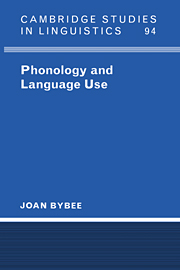Book contents
- Frontmatter
- Contents
- List of Figures
- List of Tables
- Acknowledgments
- 1 Language Use as Part of Linguistic Theory
- 2 A Usage-Based Model for Phonology and Morphology
- 3 The Nature of Lexical Representation
- 4 Phonological Processes, Phonological Patterns
- 5 The Interaction of Phonology with Morphology
- 6 The Units of Storage and Access: Morphemes, Words, and Phrases
- 7 Constructions as Processing Units: The Rise and Fall of French Liaison
- 8 Universals, Synchrony and Diachrony
- References
- Author Index
- Subject Index
- Languages Index
4 - Phonological Processes, Phonological Patterns
Published online by Cambridge University Press: 03 December 2009
- Frontmatter
- Contents
- List of Figures
- List of Tables
- Acknowledgments
- 1 Language Use as Part of Linguistic Theory
- 2 A Usage-Based Model for Phonology and Morphology
- 3 The Nature of Lexical Representation
- 4 Phonological Processes, Phonological Patterns
- 5 The Interaction of Phonology with Morphology
- 6 The Units of Storage and Access: Morphemes, Words, and Phrases
- 7 Constructions as Processing Units: The Rise and Fall of French Liaison
- 8 Universals, Synchrony and Diachrony
- References
- Author Index
- Subject Index
- Languages Index
Summary
Introduction
In Chapter 3, we saw evidence against the separation of contrastive and predictable features for lexical representation, in addition to evidence that variation can be lexically specific. To account for this evidence, I proposed that detailed phonetic tokens are categorized in the lexicon, and that regularities of phonological structure are expressed in schemas. This type of network model has no place for the notion of phonological rules in the sense of a series of operations that apply to abstract cognitive units to transform them into something more similar to phonetic output forms. This is not to say that the phenomena described by traditional phonological rules do not necessarily exist. What needs to be determined at this point is what aspects of the phenomena described by phonological rules are viable aspects of language behavior, and how they might be accommodated in such a model. Moreover, the many different types of patterns that generative phonological rules try to encompass are better understood as different types of generalizations, depending upon their association with the phonetics on the one hand versus the lexicon and morphology on the other.
One aspect of phonological behavior previously described by rules that is an undeniable fact about language behavior is the presence of certain articulatory patterns that are shared across speakers and that are transferred onto the production of novel words, loanwords, and early attempts by adults at a foreign language. In the usage-based model developed here, we can describe such articulatory regularities with schemas that generalize over learned patterns that are present in the language.
- Type
- Chapter
- Information
- Phonology and Language Use , pp. 63 - 95Publisher: Cambridge University PressPrint publication year: 2001



